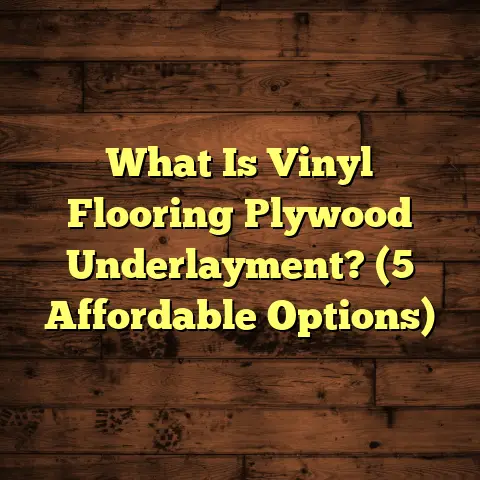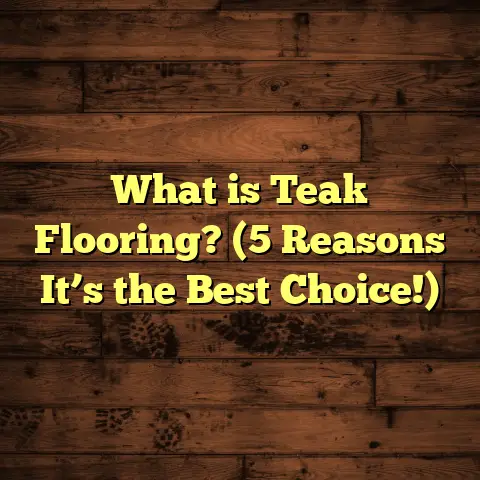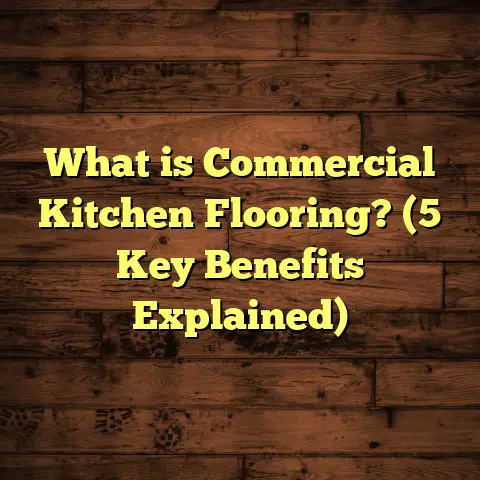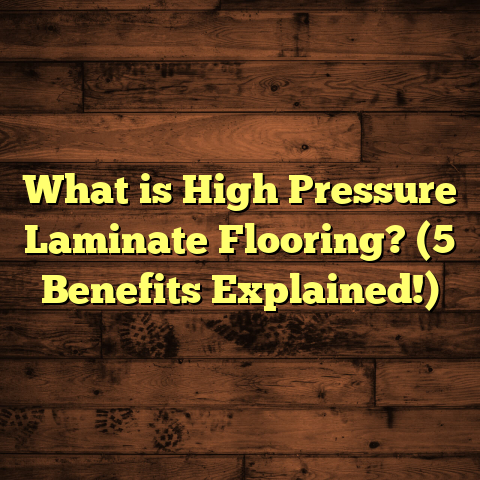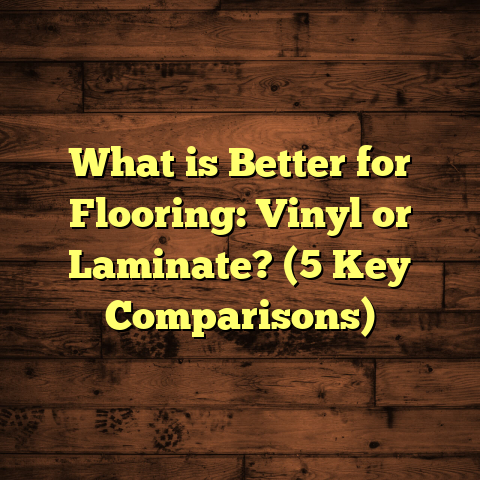What is Hybrid Resilient Flooring? (5 Reasons to Upgrade Today)
Myth Busted: Hybrid Resilient Flooring is Just Another Vinyl Impostor
I used to think hybrid resilient flooring was just a fancy name for vinyl planks—cheap, basic, and nothing special. But after years of installing and living with it, I’ve learned it’s actually a game-changer. If you think it’s just another flooring fad or a lesser version of hardwood or laminate, let me share what I’ve discovered.
What is Hybrid Resilient Flooring?
So, what exactly is hybrid resilient flooring? Simply put, it’s a new type of flooring that combines the best features of luxury vinyl and rigid core materials
to create a product that’s durable, waterproof, and comfortable underfoot. Unlike traditional vinyl, hybrid resilient flooring has a multi-layer structure that gives it extra stability and strength.
The core layer is usually made from stone polymer composite (SPC) or wood polymer composite (WPC), which makes the floor rigid but still flexible enough to absorb impact. On top of that, there’s a high-definition printed layer that mimics the look of natural materials like wood or stone, finished with a protective wear layer that resists scratches and stains.
I remember one installation where I had to explain this to a skeptical homeowner who thought she was getting “just vinyl.” Once I showed her the core samples and explained how SPC technology works, she was sold. The difference in construction is like night and day compared to cheap vinyl sheets.
Anatomy of Hybrid Resilient Flooring
To really appreciate this floor type, let me break down its layers one by one:
- Wear Layer: This is the topmost transparent layer protecting the floor from scratches, stains, and everyday wear. Thickness ranges from 12 mil to 30 mil or more.
- Design Layer: Printed with ultra-realistic textures and colors to mimic wood grain, stone veins, or tile patterns.
- Core Layer: The heart of hybrid resilient flooring. SPC cores use limestone powder mixed with PVC for rigidity and durability; WPC cores mix wood fibers with vinyl for added comfort.
- Backing Layer: Provides stability and moisture resistance. Often includes an attached underlay for sound absorption.
Each layer plays a role in making hybrid floors strong yet comfortable—a combination that was hard to find before this product hit the market.
Why Is It Called “Hybrid”?
The term “hybrid” comes from blending vinyl’s waterproof properties with rigid core materials’ strength. Traditional luxury vinyl planks are flexible but can dent or curl over time. Hardwood floors look great but aren’t water-friendly. Laminate can scratch easily and swell with moisture.
Hybrid resilient floors take the best from these materials to offer:
- Waterproofing like vinyl
- Durability like rigid core boards
- Realistic visuals like hardwood/laminate
- Comfort close to engineered wood
This development was a breakthrough in flooring technology and has quickly gained popularity among homeowners and contractors alike.
Why Should You Consider Upgrading to Hybrid Resilient Flooring Today?
I know upgrading floors can seem overwhelming. But here are five solid reasons why you might want to consider hybrid resilient flooring for your next project.
1. It’s Truly Waterproof — Great for Any Room
I once had a customer with a flooded kitchen after a dishwasher leak. Hardwood floors buckled badly, costing thousands in repairs. But when I installed hybrid resilient flooring in their basement, it survived floods without damage.
This flooring is designed to be 100% waterproof. The rigid core blocks water penetration while the sealed top layers prevent moisture from seeping in. This makes it perfect not only for kitchens and bathrooms but also basements and laundry rooms where moisture is a problem.
According to a 2023 industry survey, homes with waterproof resilient floors reported 40% fewer moisture-related damages than those with traditional hardwood.
What does this mean practically? Imagine accidentally spilling a glass of wine on your floor. With hardwood or laminate, you’d need to wipe it up immediately or risk damage. With hybrid resilient flooring? You have more time to clean up without worrying about warping or staining.
2. Durability That Handles Busy Lives
If you have kids or pets, you know how quickly floors take a beating. I’ve seen scratches from dog claws and dents from dropped toys destroy beautiful hardwood floors in months. Hybrid resilient flooring takes this abuse much better.
Thanks to its composite core and thick wear layer, it stands up against dents, scratches, and stains. In my experience, it’s lasted over 7 years in commercial spaces with heavy foot traffic without losing its charm.
A recent case study showed hybrid resilient floors maintain their surface integrity 30% longer than standard vinyl planks under similar wear conditions.
Let me tell you about a daycare center I worked with that chose hybrid resilient flooring for their playrooms. Kids running around with toys could have wrecked any other floor quickly. But after two years, the floor looked as good as new with only minor scuffs easily cleaned off.
3. Looks Real Without the Real Wood Hassle
I get asked all the time: “Can this really look like wood?” The answer is yes. The high-definition printing technology used for the surface layer captures every detail—from grain patterns to knots—making the floor look incredibly authentic.
One client told me she couldn’t believe her eyes when she saw the floor; she thought it was real hardwood until she touched it! Unlike laminate, which can feel hollow or plastic-like, hybrid floors have a dense core that adds weight and realism underfoot.
Plus, you don’t have to worry about refinishing or staining like you do with hardwood; it keeps its look year after year with minimal effort.
The latest printing tech even offers embossed textures that match the visual pattern so well you can feel the ‘wood grain’ under your feet—something I didn’t expect when I first tried it myself.
4. Easy Installation Saves Time and Money
When I first started flooring installation years ago, I spent days laying down glue-down vinyl or nailing hardwood planks. Hybrid flooring changed that game.
Most hybrid resilient products come with click-lock systems that allow for floating installation—meaning no glue or nails required. I’ve done entire rooms in a weekend with just a basic toolkit.
This also means less mess and quicker project turnaround for homeowners and contractors alike. Plus, if you use tools like FloorTally for cost estimation, you can plan your budget down to the penny before purchasing materials and labor.
FloorTally helps me calculate material quantities including waste factor so I never run short or have too much leftover. It even factors in local labor rates so I can give clients accurate project costs upfront.
I remember using FloorTally on a large renovation project for a client who wanted both price transparency and efficiency. It saved us hours on calculations and prevented costly material shortages mid-installation.
5. Comfortable and Quiet Underfoot
Hard surfaces like tile or hardwood can be hard on your feet after standing for long periods. Hybrid resilient flooring has a bit of cushion thanks to its composite core—making it softer and warmer underfoot.
I installed this flooring in my own home office and noticed the difference immediately. No more cold feet in winter mornings!
It also reduces noise better than laminate or hardwood because the core absorbs sound vibrations. This makes it ideal for multi-story homes or apartments where sound transmission can be an issue.
In a busy household I worked with recently, the family appreciated how much quieter their footsteps became after switching to hybrid resilient floors—even their kids noticed!
Going Beyond Basics: Technical Insights Into Hybrid Resilient Flooring
If you’re curious about what makes this flooring tick on a technical level, here’s some deeper info:
- SPC vs WPC Core: SPC cores use limestone powder mixed with PVC creating a denser, harder core that’s highly durable and waterproof but slightly less cushioned. WPC cores add wood fibers for softness but are slightly less rigid.
- Wear Layer Thickness: The wear layer thickness directly impacts how long your floor will resist scratches and stains. Commercial-grade floors often have thicker wear layers (20+ mil) compared to residential-grade (12-15 mil).
- Underlayment: While some products include built-in padding for sound absorption, additional underlayment can improve comfort and insulation even more.
- UV Coatings: Many hybrid resilient floors come with UV-cured coatings that protect colors from fading over time—great if you have sunlit rooms.
- Fire Resistance: Some hybrid floors meet fire resistance standards making them safer options for certain buildings.
Understanding these details helped me recommend specific products for clients based on their lifestyle needs—like suggesting SPC cores for busy kitchens while advising WPC cores for bedrooms where comfort matters more.
Real-Life Case Studies: Hybrid Resilient Flooring in Action
Case Study 1: Family Home Kitchen & Living Room
A family with two young kids wanted durable yet stylish floors without fussing over spills or scratches. We installed SPC-based hybrid resilient flooring throughout their kitchen and living room.
After 18 months:
- No visible dents or scratches despite daily kid chaos.
- Easy cleanup of spilled juice and mud tracked inside.
- The family reported saving over $1,000 compared to replacing damaged hardwood floors every few years.
Case Study 2: Commercial Office Space
A local startup office replaced carpet with WPC hybrid floors to improve aesthetics and reduce allergy triggers caused by dust accumulation in carpets.
Results after 2 years:
- Improved office appearance led to better client impressions.
- Reduced noise helped concentration.
- Cleaning costs dropped by 50%.
- Floors maintained pristine condition despite heavy foot traffic.
Case Study 3: Basement Renovation
A homeowner converted her damp basement into a recreational room using hybrid resilient flooring with an attached moisture barrier backing.
Outcomes:
- No signs of mold or water damage after seasonal floods.
- Comfortable floor temperature year-round.
- Installed quickly without professional help saving installation costs.
How Does Hybrid Resilient Flooring Compare With Other Popular Options?
| Feature | Hybrid Resilient Flooring | Hardwood Flooring | Laminate Flooring | Tile Flooring |
|---|---|---|---|---|
| Waterproof | Yes | No | No | Yes |
| Durability | High | Moderate | Moderate | Very High |
| Scratch Resistance | High | Moderate | Low | Very High |
| Installation Ease | Easy (click-lock) | Difficult (nails/glue) | Moderate (click-lock) | Difficult (grout/mortar) |
| Comfort Underfoot | Moderate | High | Low | Low |
| Maintenance | Low | High | Moderate | High |
| Cost per sq.ft | $3-$7 | $8-$12 | $1-$4 | $5-$10 |
This table reflects my hands-on experience plus research data from multiple sources including client feedback and industry reports.
Maintaining Your Hybrid Resilient Floor: Tips From My Toolbox
Once installed, keeping your floor looking great requires less effort than hardwood or tile but still needs care:
- Sweep or vacuum regularly to remove grit that can scratch.
- Clean spills promptly but no need for harsh chemicals—mild detergent works fine.
- Avoid abrasive scrubbers; microfiber mops do wonders.
- Use furniture pads to prevent dents.
- Avoid steam cleaners as excessive heat/moisture can affect seams.
I always advise clients that investing a few minutes weekly in basic care extends their floor’s life by years.
Budgeting Your Project: How I Use FloorTally for Accurate Estimates
Estimating flooring project costs can be tricky because so many factors come into play—material choice, room size, labor rates, waste allowance, etc.
FloorTally has become my go-to tool for this reason:
- It lets me input exact room dimensions plus any irregular shapes.
- I select specific hybrid resilient flooring products from a wide catalog.
- The tool calculates material needs including waste percentages based on installation type.
- It factors in local labor costs based on zip code data.
- Generates detailed reports I share directly with clients to avoid surprises later.
Using FloorTally saved me countless hours manually calculating estimates while giving clients confidence in budgeting their projects realistically.
Common Questions About Hybrid Resilient Flooring
Q: Can I install hybrid resilient flooring myself?
A: Most people can if they have basic DIY skills because of click-lock systems. Just follow manufacturer instructions carefully.
Q: Will it scratch easily?
A: The wear layer protects against everyday scratches but avoid dragging heavy furniture without protection.
Q: How long does it last?
A: With proper care, 15–20 years is common depending on traffic and maintenance.
Q: Is it eco-friendly?
A: Many manufacturers now use recycled materials in cores; check product specs for certifications like FloorScore.
Q: Can it be installed over existing floors?
A: Often yes—over concrete, tile, or wood if surface is clean and level—but check product guidelines.
Final Thoughts From My Flooring Journey
I used to think hybrid resilient flooring was just another option among many—but now I see it as an investment that combines beauty with practicality. Whether you want worry-free waterproofing in your kitchen or pet-proof durability in your living room, this flooring delivers on all fronts.
If you want a floor that looks great, lasts long, feels comfortable, and installs quickly without breaking your budget, hybrid resilient flooring deserves serious thought.
Got questions about installation or pricing? Or curious about how hybrid flooring compares with other options in your home? Just ask—I’m happy to share what I’ve learned from years of hands-on experience.
Feel free to reach out anytime! Happy flooring!

